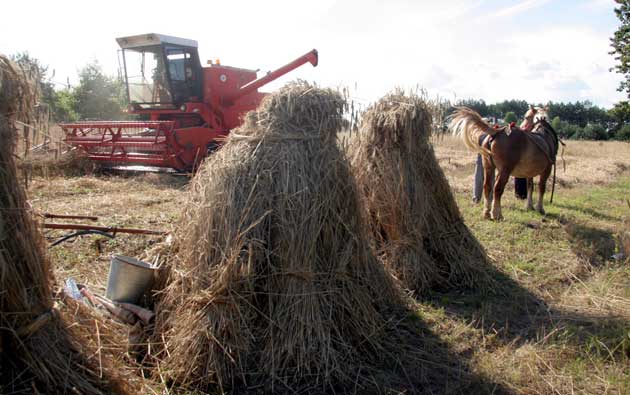Farmers make hay thanks to food crisis

Profits for Britain's 30,000 grain farmers will increase by 40 per cent this year because of global food shortages, agricultural analysts said yesterday.
The wheat harvest, which will begin over the next fortnight, is likely to be the biggest since 2000, according to the Home Grown Cereals Authority, and is expected to come in at around 16.5 million tonnes. This compares with an average of 14 to 14.5 million tonnes in recent years, and a low point last year when torrential rains cut the crop to 13.2 million.
But this year, the ending of the EU's set-aside schemes and the attraction of higher global grain prices have led to a surge in planting, with the total cereals area across Britain up by an astonishing 13 per cent in just 12 months and wheat alone up by 14 per cent. Whereas two or three years ago wheat was selling at about £70 per tonne, following the dramatic price rises that began across the world last summer, the figure now is more like £120-£140, depending on quality. The peak was more than £160 per tonne earlier this year.
The sort of difference this makes to incomes is illustrated in the computer model of a cereal farm run by the agricultural business consultants Andersons. Andersons' model (which grows virtual wheat, oilseed rape and beans), made £148 per hectare in 2006, but only when EU and other subsidies of £230 per hectare had been taken into account – and thus it failed to break even. But last year it made £346 per hectare, and this year it is predicted to make £430 – its best year ever.
It may mean the best summer for arable farmers in a decade – provided the rain holds off over the next couple of weeks. Heavy August rain means that much of the wheat is of poorer quality and can only be sold for animal feed, at substantially lower prices than milling wheat – the high-quality grain which used to make bread and biscuits.
The optimistic outlook has led to a surge in agricultural land prices, which have risen by 50 to 60 per cent over the past 12 months. However, even if the rain stays away and this year truly is a bonanza, the Andersons' farm model predicts that in 2009, its profits will fall sharply back to £243 per hectare, as steeply rising input costs begin to bite.
This year's high profits should therefore be used for investment in farm infrastructure and machinery for which there has been no cash in recent years, according to Rob Hughes, partner in another farm business consultancy, Brown & Co. "There's a million farming businesses out there that have been living off depreciation for a long time, and haven't been able to reinvest," Mr Hughes said. "This is the year to bank profits against the future, restructure debt or reinvest in machinery and infrastructure."
British grain farmers will do well this year because they bought their inputs for the 2007 harvest, such as fertiliser and diesel for tractors, at last year's prices – which have now shot up. Carmen Suarez, chief economist of the National Farmers' Union, said that between summer 2006 and now, the price of ammonium nitrate, a principal fertiliser, had increased by more than 120 per cent, while some other fertilisers had increased by more than 200 per cent. "This is now having a massive impact," she said. Fertiliser prices are closely linked to energy prices, which have risen steeply. The cost of diesel has also soared.
But while grain farmers are doing well, livestock farmers are not – partly because the increase in the wheat price means a rise in the cost of feed. Although cereal farms are expected to see profits boosted by 38 per cent, the average pig farmer is expected to make a loss of more than £4,000, while poultry farmers have seen profits cut by 90 per cent.
A farmer's story
Richard Hirst, Carr Farm, Ormesby
Richard Hirst owns a farm on the edge of the Norfolk Broads. He grows milling wheat and malting barley on half of his 800 acres and says his profits will be "about 40 per cent" up on last year. "But last year we didn't make anything," he says. "We just about broke even."
Next year, he says, profits are likely to fall back to the level of the past couple of years because of the heavy rise in costs. "Fertiliser? £147 a tonne last year. Now it's £350- plus. And diesel has more than doubled." But he does accept that for now, "from an arable point of view, yes, things are better."
Join our commenting forum
Join thought-provoking conversations, follow other Independent readers and see their replies
Comments
Bookmark popover
Removed from bookmarks